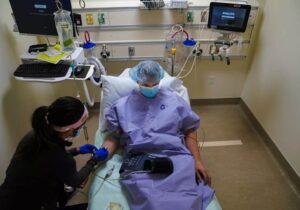Good communication is usually a two-way street; an exchange of information between two parties of relatively equal status – economically and socially. Patients are inherently vulnerable, however, cast in a role not of their choosing. And much of what patients encounter is often new, difficult, and sometimes frightening. Such vulnerability creates an inherent imbalance of power between physicians and patients. Furthermore, some patients view physicians as authority figures due to their experience, knowledge, and training. As a result, communication between doctors and patients can, at times, be challenging. And yet, how doctors talk with patients can impact medical care and treatment.
What Good Communication Between Doctors and Patients Feels Like When It’s Working …
Jackie spoke highly of her oncologist because he listened, he took the time, and he was willing to take her input.
I really liked his manner and the way he went through things, but most importantly he was willing to listen to me like when I said, ‘hey, I know you’re going to recommend chemotherapy’, and he’s like, ‘well okay let’s look at this.’ And then he’d pull out his laptop and then go online… to that company and, look at the statistics that they have there… then he’d show me. ‘These are the reasons why… you might be able to convince me about this, but let me just show you that these are risks.’… very busy guy, but if I had a question, he was going to sit there and answer it.
Jackie
Additionally, Jackie’s oncologist listened when she wanted to incorporate cooling cap therapy¹ during chemotherapy in an effort to minimize hair loss. Even though the hospital didn’t offer such therapy, the treatment team was willing to support Jackie’s efforts to make this happen.
Ultimately, Jackie chose not to incorporate cooling cap therapy, but having an oncologist willing to listen and help make this happen established trust. As the patient, she felt she had some control in the decision-making and her treatment options. Good communication between doctors and patients begins with the actions a physician takes – for Jackie that meant a willingness to listen.
… and When It’s Not
Jaime, in her search for answers as to what was causing her pain, was not as fortunate as Jackie. She spent a year and a half visiting different doctors trying to get an answer. “Initially, I felt like I truly was the patient, and I didn’t know anything. And they treated me like I was an imposition, and I, it was all in my head; I was a hypochondriac, and you know, high maintenance patient.”
Once Jaime found the physician that properly diagnosed what was causing her pain, stage 4 colorectal cancer, it all changed. Jaime describes the difference:
I actually felt like I was part of a team, which made me feel 100% better; it’s not all in my head… I listened to my body, and I knew something was wrong, and they agreed with me. And I felt a whole lot more comfortable then, working with them, and, and getting their opinions and going through treatment options because I was part of the team.
Jaime
5 Examples of Good Communication Between Doctors and Patients
Finding ways to humanize patient care is essential. And as difficult as it might be at times, patients need to hold doctors accountable Here is a short list of how your doctor should communicate with you:
- Takes your concerns seriously and is not dismissive
- Asks questions and listens to your concerns
- Considers you, the patient, part of the treatment team
- Consults with you regarding treatment options
- Treats you as a person first, and a patient secondarily
Many doctors make tremendous efforts to ease communication with patients. But when that doesn’t happen, patients must speak up. And if you feel dismissed as a patient, perhaps it may be time to find another doctor.
* Quotes in this post are from interviews conducted for my book, Navigating Illness: The Patient Experience, a work in progress. Names were changed upon an individual’s request.
¹ (2018) Cold Caps and Scalp Cooling Systems. Breastcancer.org.



